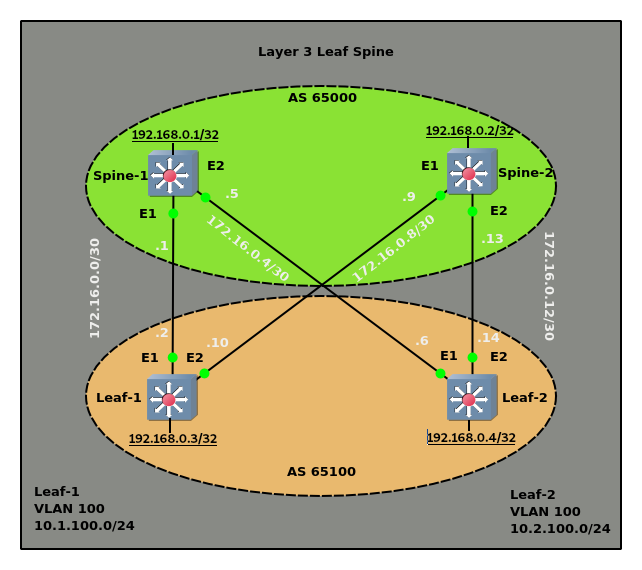In this series of posts I am going to attempt to build and maintain a reference layer 3 leaf spine design using a python script. I will be using Arista vEOS for this, but it could be adapted to another NOS with some template modifications.
Topology

IP Addressing
192.168.0.0/16will be dedicated to loopbacks, starting with192.168.0.1/32.172.16.0.0/12will be dedicated to point to point links between the spines and leafs, starting with172.16.0.0/30.10.0.0.0/8will be used for server VLANs. With leaf-1 using10.1.0.0/16, leaf-2 using10.2.0.0/16and so on.
The only IP info that is not on the diagram is the management network, which will be in its own VRF.
The subnet is 198.51.100.0/24. We will be using it in the baseconfig portion after that we will be using
the DNS names of the switches.
Building the baseconfig
The plan is to use python to configure the switches without having to manually ssh or console to the switches, however, we cannot do that until the servers have a base configuration applied. Rather than applying that manually in advance, I am going create a Jinja2 template with the base config and two yaml files to store the data. We will still be dumping the config into the console after its generated, but these files will be expanded in future posts where we actually automate configuration changes.
hosts.yaml
spine-1:
managementip: 198.51.100.254/24
managementgw: 198.51.100.1
site: ny
spine-2:
managementip: 198.51.100.253/24
managementgw: 198.51.100.1
site: ny
leaf-1:
managementip: 198.51.100.252/24
managementgw: 198.51.100.1
site: ny
leaf-2:
managementip: 198.51.100.251/24
managementgw: 198.51.100.1
site: ny
groups.yaml
defaults:
domain: example.net
ntpserver1: 0.pool.ntp.org
ntpserver2: 1.pool.ntp.org
nameserver1: 8.8.8.8
nameserver2: 8.8.4.4
domainname: example.net
username: admin
password: admin
ny:
timezone: America/New_York
arista_eos:
nos: arista_eos
iprouting: True
lldp: True
baseconfig.j2
! Base configuration
!
hostname {{ hostname }}
ip name-server {{ defaults.nameserver1 }}
ip name-server {{ defaults.nameserver2 }}
ip domain-name {{ defaults.domainname }}
!
ntp source Management1
ntp server {{ defaults.ntpserver1 }} prefer
ntp server {{ defaults.ntpserver2 }}
!
username admin role network-admin secret {{ defaults.password }}
!
clock timezone {{ site.timezone }}
!
vrf definition management
!
! Use https in production
!
management api http-commands
protocol http
no shutdown
!
vrf management
no shutdown
!
interface Management1
vrf forwarding management
ip address {{ host.managementip }}
!
ip route vrf management 0.0.0.0/0 {{ host.managementgw }}
!
end
Now that we have our data and config template its time to write some python to generate the configs.
configureleafspine.py
#!/usr/bin/env python3
from jinja2 import Environment, FileSystemLoader
import yaml
class ConfigureLeafSpine():
"""Class to configure and maintain leaf spine switches"""
def __init__(
self,
hosts,
groups,
baseconfig
):
with open(hosts) as file1:
self.hosts = yaml.load(file1)
with open(groups) as file2:
self.groups = yaml.load(file2)
self.baseconfig = baseconfig
self.ENV = Environment(loader=FileSystemLoader('.'))
def generatebaseconfig(self):
"""Generates base configuration files"""
template = self.ENV.get_template(self.baseconfig)
for key, value in self.hosts.items():
config = template.render(
defaults=self.groups['defaults'],
hostname=key,
host=value,
site=self.groups[value['site']]
)
filename = 'configs/{0}-base.config'.format(key)
with open(filename, 'w') as file:
file.writelines(config)
if __name__ == "__main__":
lsconfig = ConfigureLeafSpine(
'hosts.yaml',
'groups.yaml',
'baseconfig.j2'
)
lsconfig.generatebaseconfig()
I added if __name__ == "__main__": so that I could run the file and it would generate the configs. I set it up as class because the intention is to use this class in other scripts.
After running the file there are 4 files in the configs folders.
spine-1.base.config
! Base configuration
!
hostname spine-1
ip name-server 8.8.8.8
ip name-server 8.8.4.4
ip domain-name example.net
!
ntp source Management1
ntp server 0.pool.ntp.org prefer
ntp server 1.pool.ntp.org
!
username admin role network-admin secret admin
!
clock timezone America/New_York
!
vrf definition management
!
! Use https in production
!
management api http-commands
protocol http
no shutdown
!
vrf management
no shutdown
!
interface Management1
vrf forwarding management
ip address 198.51.100.254/24
!
ip route vrf management 0.0.0.0/0 198.51.100.1
!
end
spine-2.base.config
! Base configuration
!
hostname spine-2
ip name-server 8.8.8.8
ip name-server 8.8.4.4
ip domain-name example.net
!
ntp source Management1
ntp server 0.pool.ntp.org prefer
ntp server 1.pool.ntp.org
!
username admin role network-admin secret admin
!
clock timezone America/New_York
!
vrf definition management
!
! Use https in production
!
management api http-commands
protocol http
no shutdown
!
vrf management
no shutdown
!
interface Management1
vrf forwarding management
ip address 198.51.100.253/24
!
ip route vrf management 0.0.0.0/0 198.51.100.1
!
end
leaf-1.base.config
! Base configuration
!
hostname leaf-1
ip name-server 8.8.8.8
ip name-server 8.8.4.4
ip domain-name example.net
!
ntp source Management1
ntp server 0.pool.ntp.org prefer
ntp server 1.pool.ntp.org
!
username admin role network-admin secret admin
!
clock timezone America/New_York
!
vrf definition management
!
! Use https in production
!
management api http-commands
protocol http
no shutdown
!
vrf management
no shutdown
!
interface Management1
vrf forwarding management
ip address 198.51.100.252/24
!
ip route vrf management 0.0.0.0/0 198.51.100.1
!
end
leaf-2.base.config
! Base configuration
!
hostname leaf-2
ip name-server 8.8.8.8
ip name-server 8.8.4.4
ip domain-name example.net
!
ntp source Management1
ntp server 0.pool.ntp.org prefer
ntp server 1.pool.ntp.org
!
username admin role network-admin secret admin
!
clock timezone America/New_York
!
vrf definition management
!
! Use https in production
!
management api http-commands
protocol http
no shutdown
!
vrf management
no shutdown
!
interface Management1
vrf forwarding management
ip address 198.51.100.251/24
!
ip route vrf management 0.0.0.0/0 198.51.100.1
!
end
Apply config and test
I cut and paste each config into in the switches and confirmed connectivity.
PING spine-1 (198.51.100.254) 56(84) bytes of data.
64 bytes from spine-1 (198.51.100.254): icmp_seq=1 ttl=64 time=1.15 ms
64 bytes from spine-1 (198.51.100.254): icmp_seq=2 ttl=64 time=0.676 ms
64 bytes from spine-1 (198.51.100.254): icmp_seq=3 ttl=64 time=0.771 ms
--- spine-1 ping statistics ---
3 packets transmitted, 3 received, 0% packet loss, time 28ms
rtt min/avg/max/mdev = 0.676/0.865/1.149/0.205 ms
Next Steps
So far we have built a base configuration generator and cut and pasted a config. This is not really automation yet, but it is a start. In the next post we will be creating the data files and building the configuration for the spine switches.
All of the files used in this post can be found here.